I’ve been in New York for over a month now and I’m a little embarrassed to say this past weekend was the first time I set foot in an art museum. After all, I’d made several plans to visit the MoMA, Guggenheim, The Metropolitan Museum of Art, etc. before even coming to work in the city. But in reality, on the list of priorities, work came first, then seeing Nicki Minaj on Good Morning America, and the likes of The Nightly Show with Larry Wilmore.
I’ve single handedly kept LYFT in business these past two months, so being the budget conscious individual that I am, I decided I’d walk to the High Line instead of taking transportation the ten or so blocks north. From there I decided to make my way down to the New Whitney Museum of American Art. I had a moment of pause where I contemplated switching directions and going to the MoMA instead. In regards to the New Whitney my friends had said, “it’s not really special,” Yelp reviews questioned, “is it really art?”—After much contemplation of whether it’d be “worth my time” to go to the Whitney, I figured I would never know how I felt unless I went and I decided for myself… and so I continued to mosey along The High Line.
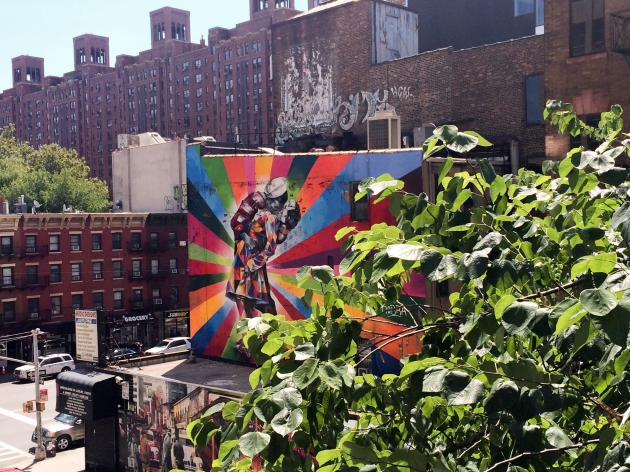
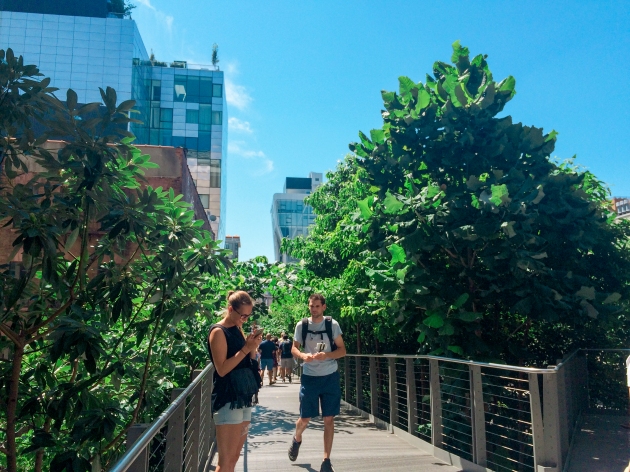
I did not need Google maps to identify the Whitney when I saw it towering over Chelsea. I was impressed with the façade and it’s multiple tiers of terraces looking over the city. The High Line alone is full of innocuous stops that provide clear views down the streets of New York—views I had not typically seen from my LES apartment. Taking in this atmosphere alongside tourists and elderly, for the first time it dawned on me that in New York things like sunlight, plants, and an unabated view are privileges often only the wealthy elite of New York can afford.
The High Line is something that gives a utilitarian feel to the city—much like Central Park with its banners that read, “This is your park. We just take care of it for you.” They’re essentially designed to make you feel some sort of ownership. I imagined someone, probably from the city, trimming the trees for me, but even then—wouldn’t the park be as much the park of the people maintaining it, as it is mine? In the context of ownership, wage gaps, the value of space and property, I figured these public spaces don’t have equal value to all people—especially between those who maintain it, those who casually visit, and those who pay to have their name engraved on it.
Even public space has a hierarchy, and it makes me think a lot, because even in areas that are meant to draw people from a variety of backgrounds, sometimes the opposite effect occurs.
In thinking about this, my mind is drawn to the moment when one of my friends attempted to tell me a “joke” as we walked by a public park in East Village. A group of pre-school children in lime green shirts played in city water before rolling down slides, and it looked like they were a part of some sort of summer day camp program.
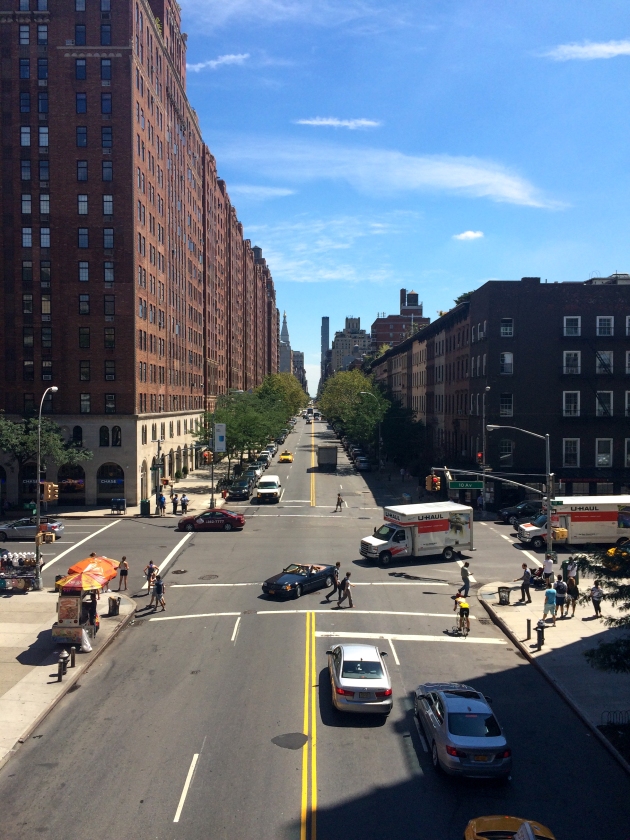 As we passed by my friend asked, “Is this where the rich kids play?”
As we passed by my friend asked, “Is this where the rich kids play?”
“Sure,” I answered nonchalantly.
“It’s a joke,” he replied.
I laughed nervously as I got what he was saying.
It’s an awful joke, I guess, because there’s a cynical truth behind what it implies. Something about the way our society is built makes me laugh at the idea of a mother from the Upper Eastside bringing her child to play at this park with East Village children.
This raises a lot of questions—questions I don’t know how to ask/answer right now. So let’s talk about the Whitney.
At the entrance, I walked through glass doors, purchased a $20 ticket (kicked myself for forgetting my student ID to get the discounted price), and threw in an extra $6 for an audio tour.
I’m not the biggest fan of audio tours, but since I was alone and walked in with a bit of uncertainty, I thought the context of an audio tour would help me gain an appreciation for whatever I was about to witness.
The first floor of the Whitney had portraits of Whitney women and drawings from the studio they had frequented. As I listened through the foam pads of my headset, while a story unfolded about the progressive nature of the Whitney women in a amid ultra-conservative standards that frowned upon women participating in art and shamed the idea of posing for a portrait in pant-legged silk pajamas.
Afterward, I went up to the fifth floor.
I don’t think I’ve ever witnessed such a wide diversity of artists’ work on a single floor. The paintings and sculptures were certainly unconventional—hair and wire, projectors, sex-toys, hand made children’s toys, etc. Although the mediums were diverse, among a majority of the pieces I felt a very pronounced tone of sadness, guilt, pain, and an attempt to reconcile these emotions in a society that had denied these artists the ability to do so in their every day life.
One portrait featured a woman’s back with a stick figure drawing of two women holding hands in front of a square house. The drawing was etched into her skin with a scalpel.
I cringed at the thought of trusting someone to wield a scalpel and carve a crude drawing into my back. I thought of the level of vulnerability, trust, and ultimately, the artist’s pain while confronting her desire for a “normal” relationship with her partner in a society that inherently treated her as “other.”
Many of the pieces at the Whitney are what many people would call straight up ugly. The Whitney confronts its ugliness, or rather defends it, with the selectivity of the work its white walls feature. Sure, some our artwork isn’t what most people like, but we put a lot of thought into selecting it. There’s this weird confrontation of ugliness throughout the entirety of the Whitney that is addressed through the architecture of the building, that some critics of architecture even claim that it begs to be called ugly.
Despite what’s inside the New Whitney, the numerous amounts of windows and terraces beckon you to look outside. It’s as if someone is imploring you to not look at the art and look outward and consequently, inward at yourself, your place in the city, and maybe even question, “what does this stuff all means?”
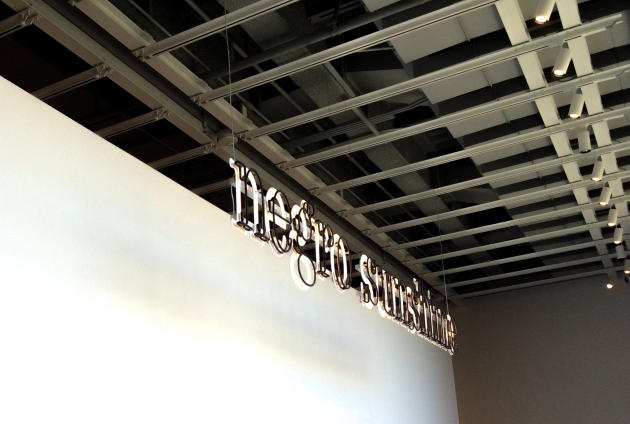
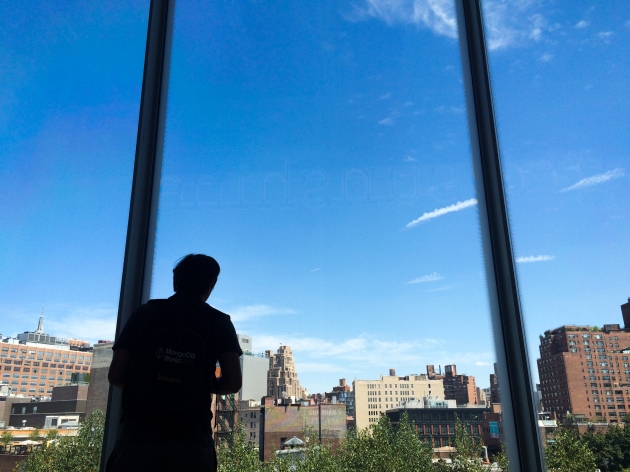
While I personally had a contemplative experience, I couldn’t help but wonder what other people were thinking and if they were sharing any of my thoughts. What I’d call a five star experience, others would say:

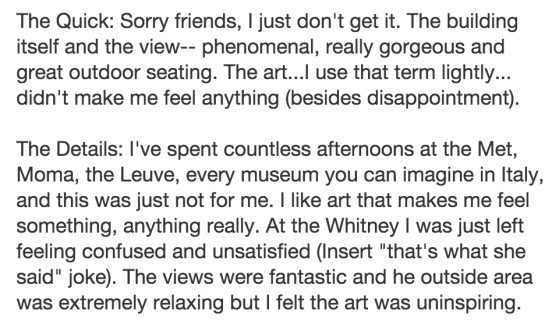

My intention is not to shame the authors of these Yelp reviews in highlighting their differing opinions. Sure, a lot of modern art is pretty ridiculous and different, but I have to question the validity of not feeling anything given the context that this art rises from.
Sometimes I wonder if people have a tendency to call art they don’t understand “modern.” I try not question negative opinions if they critic the substance of the art, but it seems that the usage of the phrase “modern art” is often a euphemism for “ugly art.” Modern art, after all, is really any art created from 1860-1970. The phrase “I don’t like/understand modern art” is such an absurd and encapsulating statement to me, I feel that same person might as well also say,
“You know, I just really don’t get all the history from colonial to revolutionary America. It makes no sense to me.”
If something is confusing or unsettling, it should be an invitation for further exploration. No one will/can force contemplation. That’s up to you as the viewer—and I certainly hope you make an attempt to dive deeper before you take the time to write a Yelp review about it.
I felt a lot of things while inside the New Whitney—many of those feelings were not warm and fuzzy, but they still made me think.
There was one sculpture that caught my attention: Fred Wilson’s Guarded View (1961). In this sculpture, four headless black mannequins stand on top of a white display, all who wear uniforms of major museums in New York: MoMA, the Jewish Museum, the Met, and the Whitney. In the audio guide, Wilson discusses the ubiquity of the mannequin, the faceless figure, their security guard uniform, and how often, he—other than the security guards and help staff of museums—was the only people of color to ever come and go within museum walls. Wilson has personally been employed as a museum security guard, and during that time, he felt this weird tension of being on display with the art, yet forced to be silent and invisible to visitors. This sense of anonymity and invisibleness is a sentiment many museum guards apparently shared. Wilson notes how one guard confided that his coworkers failed to acknowledge him with a hello, even after working together for thirty years.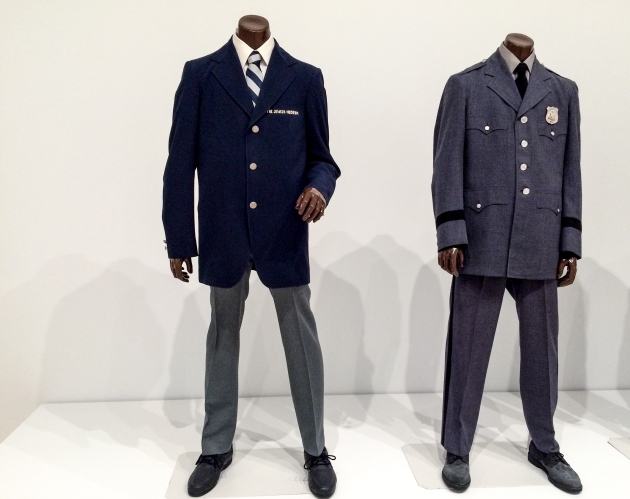
As the recording of the audio finished, I looked around at the people near me: pale skinned women who took selfies in front of a neon white AMERICA sign with backwards letters; confused passersby quickly glancing at the uniformed mannequins before walking away; and in the corner of the hall, a black-skinned man with arms crossed at his back, wearing a uniform pinned with a gold Whitney pin: the emblem of the museum guard. He stood silently, among the white walls, and no one seemed to notice. He, of course, was not the only uniformed minority that many people walked pass and failed to acknowledge.
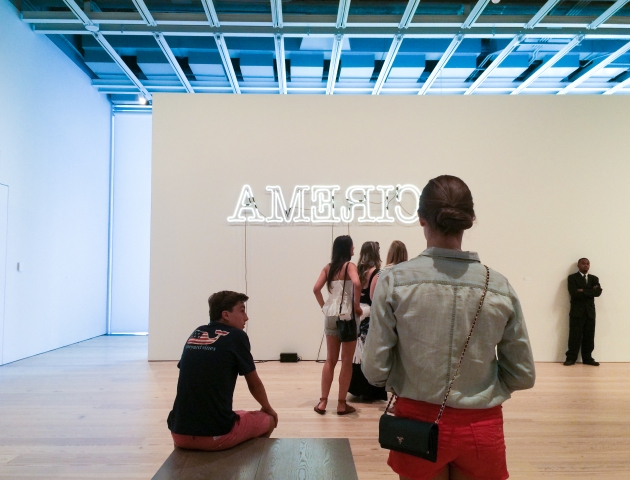 54 years after the creation of Guarded View, I feel saddened that social inequality still exists at stark levels. It makes me wonder, whose view is guarded? And with what are they guarding their view?
54 years after the creation of Guarded View, I feel saddened that social inequality still exists at stark levels. It makes me wonder, whose view is guarded? And with what are they guarding their view?
Could it be wealth? Status? Institutions?
How about the art of the lesser-known artists? Is it enough to display diverse art in prominent locations? Does that mean minorities’ voices are heard?
What is the role of cultural institutions, and how can we prevent them from being so prestigious, so exhibiting, that they strip the power away from the artist and simply make their work items of objectification?
Seeing as even cultural institutions that seek to promote the arts are not without fault, these are questions I wish to seek further during my limited time left in New York. I doubt I’ll find all the answers in the next two weeks, but I can certainly try.


 As we passed by my friend asked, “Is this where the rich kids play?”
As we passed by my friend asked, “Is this where the rich kids play?”





 54 years after the creation of Guarded View, I feel saddened that social inequality still exists at stark levels. It makes me wonder, whose view is guarded? And with what are they guarding their view?
54 years after the creation of Guarded View, I feel saddened that social inequality still exists at stark levels. It makes me wonder, whose view is guarded? And with what are they guarding their view?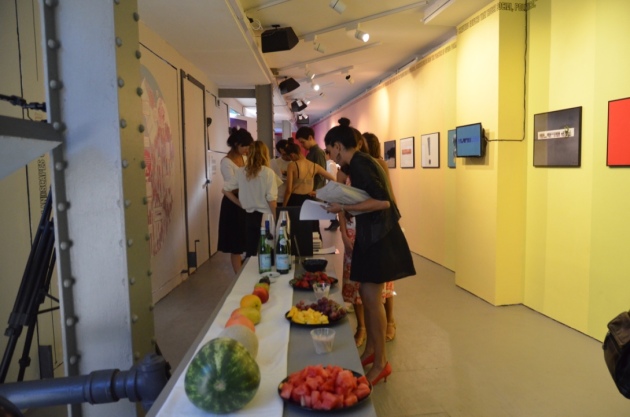
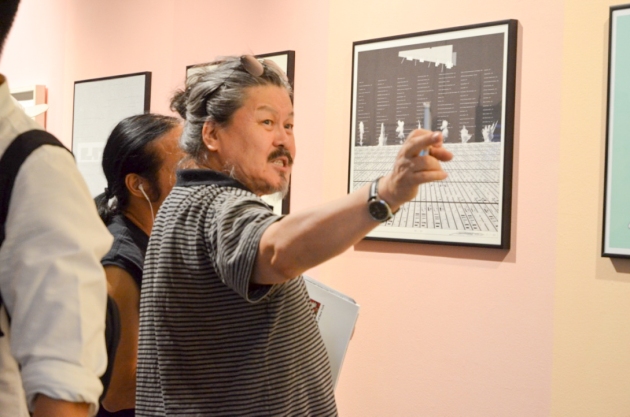
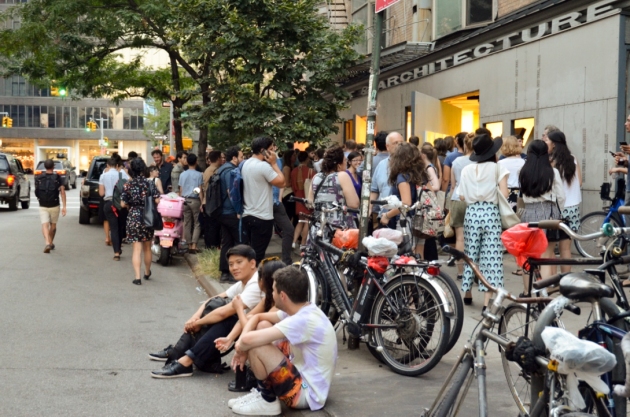
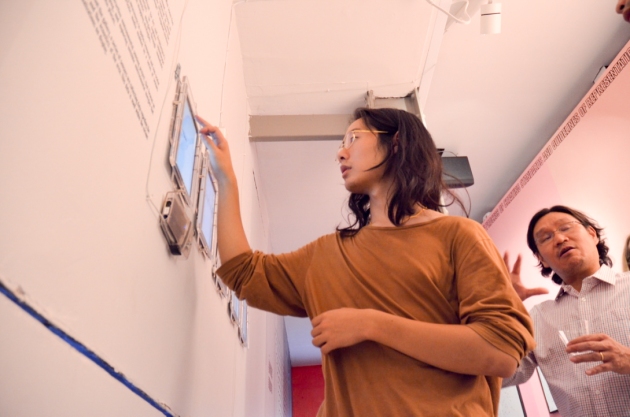
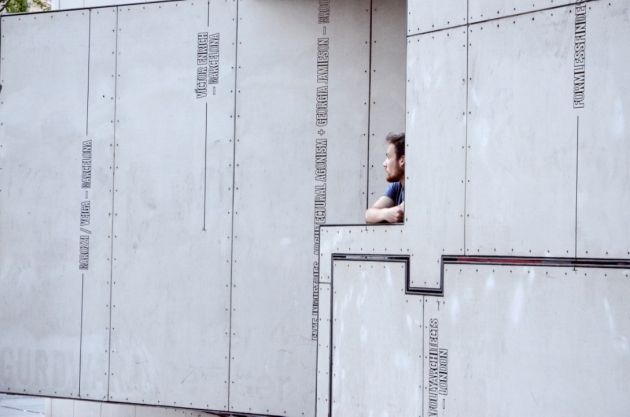
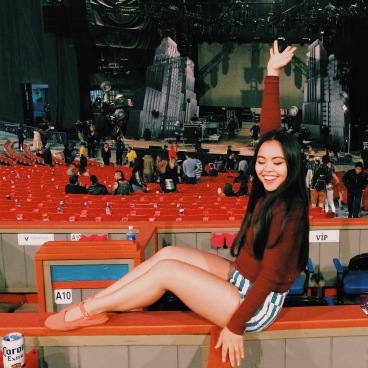
Recent Comments